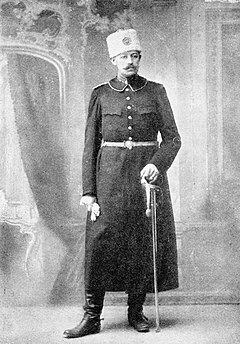Iranian Gendarmerie
| Iranian Gendarmerie | |
|---|---|

Seal of the Islamic Republic of Iran Gendarmerie
|
|

Seal of the Iranian Imperial Gendarmerie
|
|
| Agency overview | |
| Formed | 1910 |
| Dissolved | 1991 |
| Superseding agency | Law Enforcement Force of Islamic Republic of Iran |
| Legal personality | Governmental: Government agency |
| Jurisdictional structure | |
| National agency | Iran |
| General nature | |
| Specialist jurisdictions |
|
| Operational structure | |
| Persian Central Government Gendarmerie Jhāndārmeri-ye Dowlati |
|
|---|---|

General Harald Hjalmarson in Persia, 1911
|
|
| Active | 1911-1920 |
| Country | Persia (Iran) |
| Allegiance | to the Shah of Persia |
| Size | 7,200 |
| Patron | Ahmad Shah Qajar |
| Colors | light blue, grey and gold |
| Engagements | Shiraz, Kazerun, Boroujerd, Soltanabad |
| Commanders | |
| Notable commanders |
Gen Jarl Hjalmarson |
The Iranian Gendarmerie also called the Government Gendarmerie (Persian: ژاندارمری دولتی Žāndārmirī-ye Daulatī), was the first modern highway patrol and rural police force in Iran. A paramilitary force, it also played a significant part in politics from its establishment in 1910 during the Qajar dynasty until the advent of the Pahlavi dynasty in 1921. It continued to serve until the end of the Pahlavi era and was modernized into the Imperial Iranian Gendarmerie. Originally established as a constitutional army, the force employed Swedish officers in command of Iranian personnel to perform both traditional police duties and conduct military campaigns against tribal forces. In 1991 the Iranian Gendarmerie was merged with other police forces to form the Law Enforcement Force of Islamic Republic of Iran.
Throughout the nineteenth century military modernization was a constant preoccupation of Iranian reformers and the history of the Qajar period is peppered with attempts to create a standing army on the European model. As a neutral choice between Britain and Russia, the Persians would choose that Sweden would be the country given the task to secure their trade routes and unify the country. On 15 August 1911, the Swedish Major Harald Hjalmarson would be given the rank of General and put in command of the Persian Gendarmerie. Many other officers, often recruited from the Swedish aristocracy would now come to follow in Hjalmarson's footsteps.
During the First World War the officers of the Swedish Gendarmerie, who like most of the Iranian intelligentsia and constitutionalists were sympathetic towards Germany, helped the Central Powers and at one point in autumn 1915 seized control of Shiraz with the connivance of the German-trained provincial governor Mehdi-Qoli Mokhber'ol Saltaneh Hedayat. After the 1921 coup d'état the War Minister Reza Khan, merged the two viable military forces which existed in Iran at that point i.e. the Cossack division and the Gendarmerie, to create the modern Iranian national army. A rural police, amnieh, was created and the nazmieh or the police force was also revamped and placed under the Iranian officers.
...
Wikipedia
